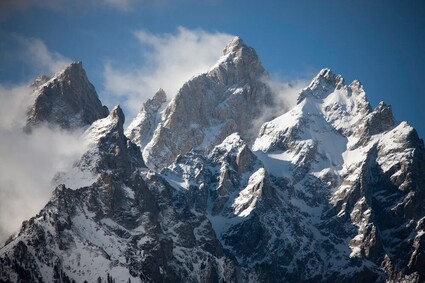Rockfall changes world-famous Teton skyline forever
May 18, 2023

Tim Mayo
Jackson photographer Tim Mayo captured the dramatic and classic Cathedral Group view of the Tetons in this photograph before parts of the Second Tower, below and left of the Grand's summit, collapsed last fall.
A 'big chunk of the mountain' fell off last fall, altering the profile of the Grand's East Ridge so drastically that people can see the difference from the valley floor.
A giant rockfall has forever changed what's arguably the world's most famous natural skyline - the iconic Cathedral Group view of the Grand Teton, Teewinot and Mount Owen.
What's being called "a big chunk of the mountain" fell off last fall, altering the profile of the Grand's East Ridge so significantly that people can see the difference from the valley floor.
Part of the Second Tower on the 13,775-foot Grand's East Ridge collapsed in September 2022, changing the feature's profile from an even-sided pyramid to a pointed spire. The modification is most apparent from the north, particularly from the Cathedral Group Turnout on the Jenny Lake Loop road in Grand Teton National Park.
That's the vantage from which Teewinot Mountain, the Grand and Mount Owen align in a composition that evokes what Fritiof Fryxell called the range's distinctive "gothic note."
The triumvirate's "converging lines of spire rising beyond spire [culminating in] pointed summits ... direct one's vision and thoughts yet higher," according to a description of the moniker and mountains penned by Fryxell, Grand Teton National Park's first naturalist.
Today, the Second Tower (the first tower on the ridge is called the Molar Tooth) is more spire-like than it was before the rockfall. But is the change merely a ding in a distant facade or something more significant?
"I think people will notice," former climbing ranger and climbing guidebook author Renny Jackson said. "Anybody who has ridden that loop road or driven it gets used to those familiar sights," he said of the iconic Cathedral Group skyline.
"This thing kind of sticks out."
Most dramatic rockfall
Former climbing guide Paul Horton was hiking to a camp beneath the south side of the Second Tower last summer when he noticed a usually clear flow of snow runoff was tainted with mud. Later in the summer other climbers began reporting rockfall from the tower, culminating in significant cascades in early September.
Stones and boulders crashed hundreds of feet down both sides of the ridge to the Teepe and Teton Glaciers below.
"I think it's the most dramatic rockfall," Horton said of his lifetime in the Tetons.
But the extent to which the world-famous skyline was forever altered went unseen initially, perhaps because of weather. "People had seen big rockfall," Horton said, "they just didn't realize the extent of it."
Last fall after the initial hullabaloo, Horton was driving from the north - where the peaks align as the Cathedral Group - when he saw a completely different view from what he was used to.
"I slammed on the brakes," he said. "There it was in profile," a fang, not a pyramid. "That's what caught my eye and blew my mind."
The summit of the Second Tower is rarely visited by mountaineers. During the first ascent of the East Ridge by Robert Underhill and Kenneth Henderson in 1929, the climbers bypassed the obstacle.
Horton, a self-professed peak-bagger and prolific explorer, has climbed to the top of the feature. He reckons a mass of rock more than 100 feet high exfoliated from the west side of the tower, leaving the top precariously hanging over space.
"I'm not going back," Horton said.
Climbing altered?
Guidebook author Jackson recently sent the latest edition of "A Climber's Guide to the Teton Range" to the printers with some warnings regarding the changing nature of the range. "I felt I had to give a heads-up to people that these are the routes that might be affected," he said.
A crucial part of the East Ridge route passes under the now-missing part of the Second Tower. But an examination of pre- and post-collapse photographs revealed that a critical chimney that is key to bypassing the tower appears intact.
Another former Teton climbing ranger and guide, Mountain Weather meteorologist Jim Woodmencey, called the missing piece "a big chunk of the mountain." Although "the range is falling apart all of the time," the larger events are rare, he said.
"Normal rockfall occurs almost constantly," he said, "especially following rain storms and things like that."
In this instance, "I can't trace any weather effects that go with it."
Many mountaineers would attribute seemingly more-frequent large-scale rock avalanches in the world's great ranges to climate change, global warming and the melting of permafrost in rock formations. Woodmencey doesn't buy that explanation, but the end result of the change is noticeable nevertheless.
"It's much sharper of an edge on there than used to be," he said, likening the new profile to a chipped tooth.
There's been no call for a name change - "The Tower Formerly Known as The Second" comes to mind - or any significant interpretive display. Park rangers will advise climbers of specific hazards "if they start to see rockfall events of the size and frequency that we did last summer," spokeswoman Valerie Gohlke said in an email.
Meantime, those in the know and those who compare National Park Service display at the Cathedral Group Turnout to the actual profile will see the awesome power of wildness.
"That's the most beautiful thing about nature," Gohlke said, "it's always changing."
Horton agrees. "You gotta figure it's not done falling down," he said.
WyoFile is an independent nonprofit news organization focused on Wyoming people, places and policy.

Angus M. Thuermer, Jr./WyoFile
The Cathedral Group profile today sports a distinctly sharper and smaller Second Tower, below and left of the Grand Teton summit, than it did before the rockfall.
This story was posted on May 17, 2023.

